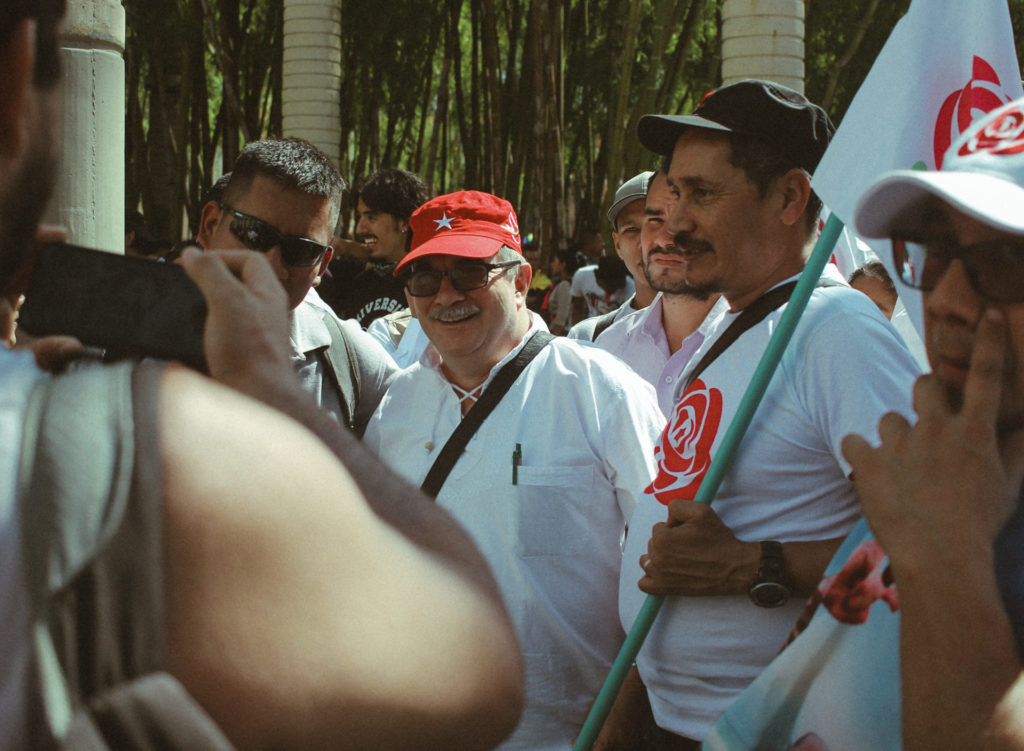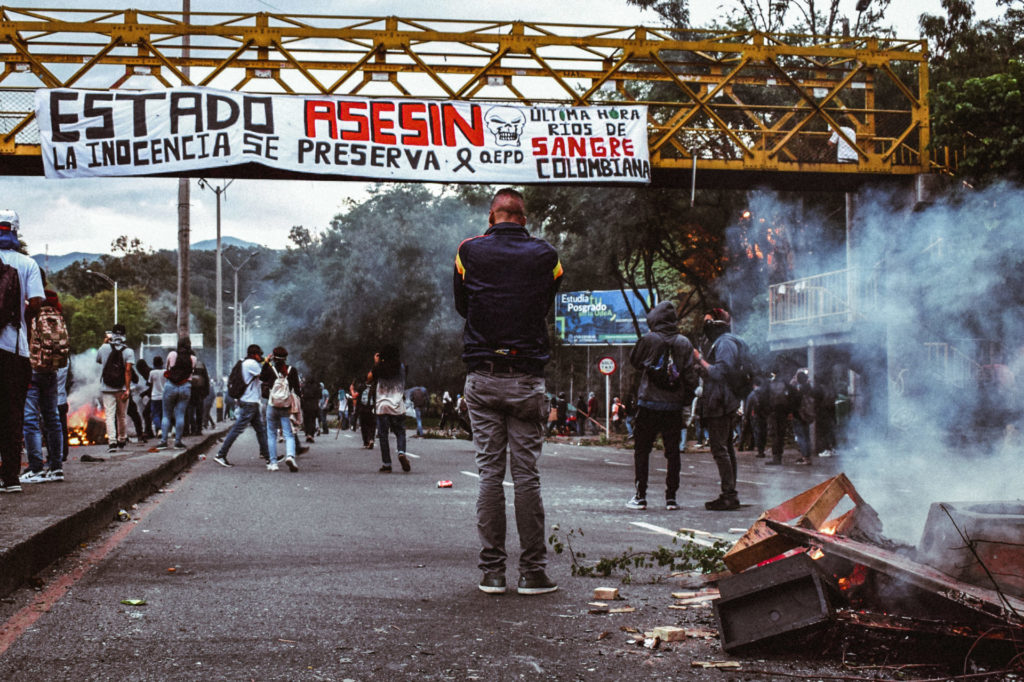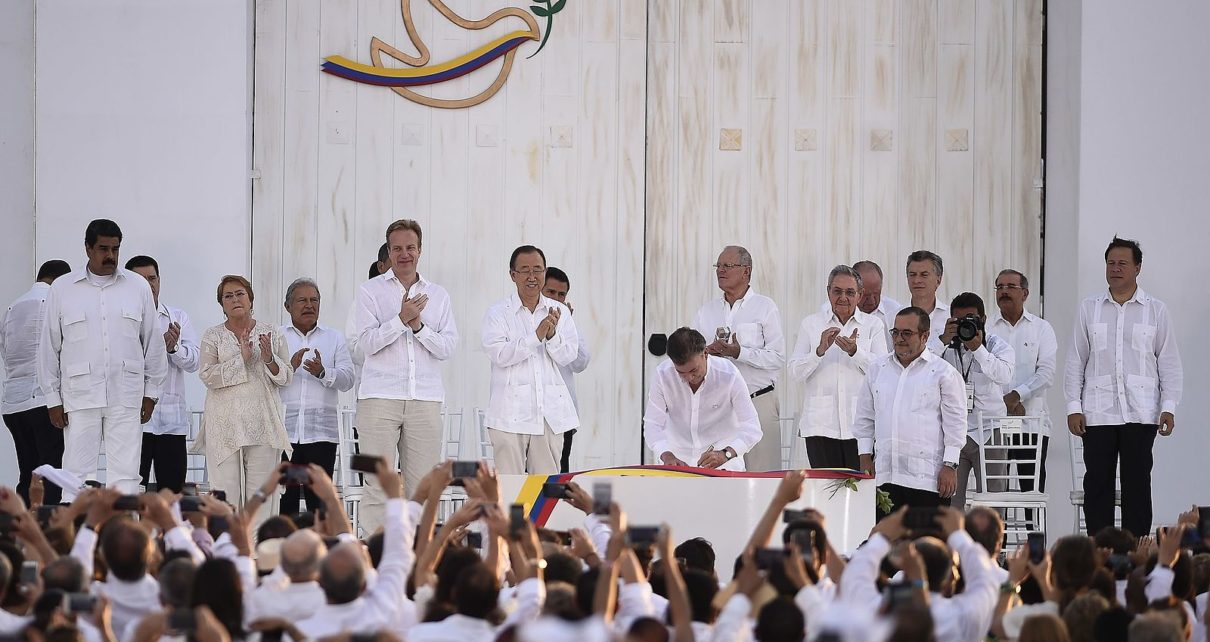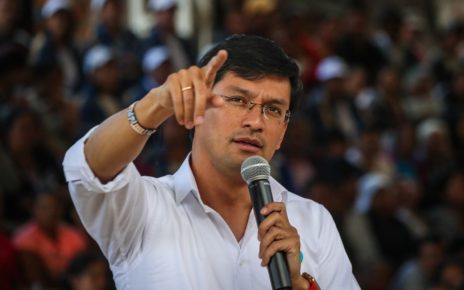[ad_1]
On November 24, 2016, in a small theatre in Bogotá, a low-key ceremonyThis was one of the greatest moments in Colombian History.
The leader of the guerilla group the FARC (Revolutionary Armed Forces of Colombia) Rodrigo Londoño Echeverry, alias “Timochenko,” and then-President Juan Manuel Santos shook hands over the final version of a peace deal that would see the insurgent army lay down its weapons for good.
But it wasn’t the first signing of the deal. Just months before, a grandiose signing ceremony had been held outside Cartagena’s historic city walls, before presidents and diplomats.
A national referendum was held to validate the four-year-old deal. This vote was meant to seperate the two ceremonies. The final peace accord was questioned to all citizens.
To the shock of negotiators, observers, and citizens, the settlement was rejected. The peace process was put on an even more unstable footing by this blow. In a matter of months, an amended deal was pushed through Congress, this time without calling a national vote, and then-Senator Iván Duque, whose party opposed the original dealTwo years later, he was elected as president.
A peace agreement was reached that led to the demobilization well over 10,000FARC members dismantled one of the largest and oldest guerrilla movements in the hemisphere. But it has also faced numerous obstacles – many from the current government itself, which made it a priority to modify parts of the deal, causing significant delays.
Implementation of many of the ambitious promises of the peace deal – from land reform to curbing illegal cocaine production, and tackling other armed actors – has fallen short. Some areas continue to see violence, while others have implemented some of the peace agreements. most prominent FARC guerrillasThe peace process has been abandoned.
Although implementation was not easy, it is still a significant achievement to bring a rebel army to the table and sign a deal that saw them exchange weapons in return for political representation. Here’s what the peace process looks like five years on.
Different kind of war
While the demobilization of the FARC removed the most significant armed actor in Colombia’s conflict, several groups continue to wage war in the countryside, often in regions exited by the FARC.
Many of those groups are remnants of Colombia’s right-wing paramilitaries (which demobilized in the mid-2000s), other organized criminal groups, and left-wing guerrillas. Others still are dissidents of the FARC themselves – groups who defected from the peace process or refused to disarm after the peace deal was signed.
“The power vacuums left by the FARC weren’t filled quickly enough by the government,” Sergio Guzmán, director and co-founder of political risk consultancy Colombia Risk Analysis told Latin America Reports.
Around 30 dissident FARC groups have sprung up, and their presence has now spread to 22 of Colombia’s 32 departments, reportsIndepaz is a Colombian peace and development think tank.
The threat of their aggressions, territorial control, and fighting with others is a major security concern. However, they don’t seem likely to threaten the stability of the government, but are rather looking to make money in criminal trades from cocaine to illegal mining.
According to Indepaz president Camilo González Posso, who spoke to Latin America Reports, these groups might reach a fifth of the FARC’s former capacity, with an estimated 3,500 armed members.
According to statistics collected by separate sources, the number of murders related to armed conflict has fallen and other indicators of violence, such as kidnapping and armed hostilities have also declined since the beginning of peace negotiations. Indepaz and Colombia’s Ministry of Defense.
Certain areas, however, are not seeing. upticksIn violence. Victims massacresIn recent years, social leaders have become more vulnerable to criminal groups exercising local control. From 2016 to 2020, 753 social leadership positions were created. killed, according to the Colombian Ombudsman’s Office, while separate figures from IndepazThis year, there have been more than 150 people killed. Around 300 formerFARC members were also killed in the years since the signing of peace.
González believes that Colombia today is entering a different reality. A Colombia today is entering a new reality, with less intensity than the long-running war against the FARC.
Yet, Colombia still faces violence. Negotiating further peace treaties may be a solution limited to just one group – the National Liberation Army (ELN), which, like the FARC, arose as a left-wing insurgency decades ago. Recent negotiations, however, have failed to produce any results. Moreover, certain FARC dissidents seem to be able to negotiate. some political motivationsThe majority of illegal armed groups in Colombia, including those that are based in Colombia, are motivated by illicit gains and territorial control. There are also no negotiations with the government.
Faced with this landscape, the current government’s heavy-handed security strategy may not be the best approach.
“The government continues to believe Colombia needs a war strategy when it comes to security, rather than generating security for peace,” Angela Olaya, co-founder and investigator of the Conflict Responses Foundation (CORE), told Latin America Reports.
While a lot of state responses have involved the pursuit of kingpins or armed leaders in the fight against drug trafficking, that’s not the same as creating security on ground. It’s a strategy closely-tied to anti-drug trafficking efforts, but in reality it doesn’t simply eliminate criminal control, rather, it can make the threat more unpredictable and even dangerous, Olaya explained.
Action is required in areas where there has been conflict historically
The peace deal promised the most ambitious transformation of Colombia’s countryside in the nation’s history, through a flagship project named the Development Program with Territorial Focus (PDET).
Over several years, the program aims to improve infrastructure, build roads, provide drinkable water, electricity, healthcare, education and more to 170 municipalities, or a third of Colombia’s land mass. This is all done in partnership with the local community.
Analysts say that these promises were short-sighted and have long-term implications.
From the start, the government dragged its feet on the PDET’s implementation. In part because of that critical time lapse, the Colombian state didn’t rapidly establish its presence in many areas where the FARC had often acted as a parallel state, providing security, justice, infrastructure and social services.
Colombians account for 43% living in povertyTo steadily reduce the control over the territory by armed groups, it is essential to provide basic services for the people and allow them the opportunity to develop legal economies. It was therefore hopedThe state could enter places where it was absent in the past, with both police and military, but also with schools, clinics, roads, and other infrastructure. But even now, rural residentsIt is common to hear the government arrive to perform anti-drug operations rather than to build the infrastructure needed by the region. Meanwhile, criminal organizations continue their war on law and wage war.
Some areas are making progress. The government states thousandsMany projects were completed and the PDET has been integrated in national and local government strategies. Many families can be credited with this. reaping the benefits of the program, from a bettering of rural roads – crucial for getting their crops to market – to setting up poultry farms aided by international agencies. It appears, however that bureaucratic inefficiencies over the years have contributed to the inability of the ground team to deploy resources.
Another key part of the peace deal’s rural program, the Integral Rural Reform, is operating at a reduced budget and capacityThis is the current version. missing half the lawsIt must function.
For the people who have been waiting for government reform for five years, that has eroded faith in the government’s capacity for change, potentially far into the future. Olaya said that key coordinators of PDET on the ground have experienced so much disappointment they were forced to quit the process to preserve their legitimacy, and to not jeopardize the efforts of other communities.

Patrick Edwards.
Are the ex-guerrillas still around?
This is not an easy task: thousands of ex-combatants must be reintegrated into society. This multifaceted task involves arranging housing and setting up educational, agricultural, and other institutions. vocational programs, assessing the needs of the former fighters and their families, and strengthening their local communities, Andrés Felipe Stapper, General Director of Colombia’s Agency for Reincorporation and Normalization (ARN), told us.
“The goal for 2021 is to have 11,627 [ex-combatants] on a path to financial sustainability: either working on a productive program, or with access to work,” said Stapper. They’ve achieved around 74% of that target, he added. “Our challenge in the medium and long term is for these productive programs to be sustainable.”
Stapper said that the ARN has also invested US$3.5 million between 2019 and 2021 in programs meant to facilitate ex-FARC members’ reincorporation into communities: these specifically focus on preventing child recruitment, tackling the stigmatization of ex-combatants, and strengthening grassroots political processes.
Then there’s the political goal – a pillar of the peace deal was for the FARC to transition from being an army to being a political actor. The party that was formed maintained its acronym FARC (standing for “Revolutionary Alternative Common Force”) for years before changing its name to “Comunes” (“Commons” in English). Contrary to popular belief, it guaranteed demobilized guerrillas 10 seats in Congress for the next two terms.
But two of those meant to occupy those seats – including the FARC’s chief peace negotiator Luciano Marín Arango, alias “Iván Márquez” – deserted, declaringThe formation of an entirely new dissident arm group in August 2019
This is not the only problem for the group. They have not performed well in elections and are unable to transition smoothly from military to civilian leadership.
“Without its 10 fixed seats, they would disappear in the coming elections,” Guzmán said.
Colombia lost its chance to end growing cocaine production
After decades of aggressive anti-drug policy, involving extensive fumigation and eradication, the peace deal gave the government a window of opportunity to work directly with communities growing coca – the plant used to make cocaine – to curb drug production long term. The program involved coca-growing families that voluntarily removed their plants in return for support from the government in setting up legal crops like cocoa and bananas.
Farmers were many eager to move awayThey were forced to work in an illegal sector that placed them under the control of criminal groups. Also challenging for families are the law enforcement interventions that routinely eradicate their crops – a practice that has a high rate of re-cultivation and has at times caused violent clashesLocal communities.
Over 99,000 households have registered for the crop substitution program (called the PNIS) to date. However, much of the implementation seems to be stagnant.
Analysts say that historical iron-fist is still being applied at the heart of the government’s anti-drug strategy, with a record 130,000 thousand hectaresLast year, security forces removed coca plants.
The numbers don’t show signs of success. Colombia’s cocaine production has been growing since 2014, and it produced more of the drug than ever in 2020: 1,200 metric tons, accordingTo the United Nations Office on Drugs and Crime.
“The vision that the peace deal laid out when it comes to illegal drugs has not been implemented by this government,” said Guzmán. “The solution isn’t to do more of the same.”
While the government claims that there is no direct evidence of a conflict, substitution program is delayedIt is moving forward. Goverment statisticsThe results show that while many families were promised the money to eliminate the drug crop, others complained. not yet received any of the funds.
Only 7% of families on the program are participating in sustainable agricultural projects – but less than a third of those are actually described as “long-term.” This, despite the fact that the majority of coca-growing familiesThose who had signed up for the PNIS kept their word and voluntarily removed their coca plants, according to UNODC verification in 2020.
The process of reconciliation and the payment of reparations to victims is moving forward
Colombia’s peace process was celebrated for its focus on the right to truth and reparations for victims of the conflict. They heard the victims during the negotiations and established numerous bodies to hear witness testimony and investigate war crimes.
While it took some time for the new special justice system to be established under the terms of the peace accord to examine and prosecute the crimes committed during the conflict, the first indictment was made. deliveredIn January 2021 against FARC former commanders. It was mostly due to controversial objections to the tribunal – named the Special Jurisdiction for Peace (JEP) – by the current government. It has been renamed the Special Jurisdiction for Peace (JEP) by the current government. making important progressThis includes both former insurgents, and those who are members of The Colombian Armed Forces.
The JEP “has managed to advance in areas that are very symbolic for Colombian society,” Olaya said.
Truth CommissionIt was also tasked to better understand the armed conflict’s causes, with the support of citizens. This will foster social healing and help avoid the repeat of history.
Stapper focuses at the local level on reconciliation that is taking place between former FARC combatants and the communities. These ex-FARC soldiers are helping to construct some of the infrastructure projects outlined in the PDET. “That starts generating bonds of trust and reconciliation, with the accompaniment of institutions, local authorities, and the ARN.”
Colombia is home to over 9 million victims. Of these, 7.3 million have been recorded. subject to reparationsThis includes psychological rehabilitation, land restitution, and the return of displacement victims to their homes.
In general, compensation has been very generous slowBut the government just recently announcedOver the next ten years, almost US$36 trillion will be spent on assistance and compensation for victims.
Is the future bright?
Despite the setbacks, the peace deal has removed one armed actor with national clout from Colombia’s complex conflict. But there is hope. third of the peace dealStill, legislation must be passed. The Colombian Presidential Elections will result in a change to the administration next year. law requires any incoming government To comply with the peace agreement.
The reality of a war country is hard to accept at every level. Many generations have been born into it. However, it is necessary for the entire country to be healed. According to Olaya, by largely removing the imminent threat of the FARC, people’s attention has moved to Colombia’s other corrosive issues.
“The great specter in Colombia used to be the FARC,” said Olaya. “When the FARC disappeared, we started to see the large flaws of institutions that portray themselves as democratic.”
You

The past couple of years have seen Colombians take to the streets in some of the largest anti-government protests in the country’s recent memory. González said that they were a symptom of how the country has progressed since the peace deal.
“Without the noise of weapons and war, people expressed themselves in the protests … They fought for democracy,” González said.
Colombia is on a difficult path to institutional and legal transformation. However, the Colombian people have the determination to make it happen.
“The reforms are far behind, but the spirit of reconciliation is moving forward, ” said González.

Mimi Yagoub, a journalist who covers security, conflict and justice in Latin America is Mimi Yagoub. Her writings have appeared, among others, in The Telegraph (Christian Science Monitor), Slate (Slate), and InsightCrime (among other places).
[ad_2]




